|
5/10/2020 The Fox Family in the Local Cemetery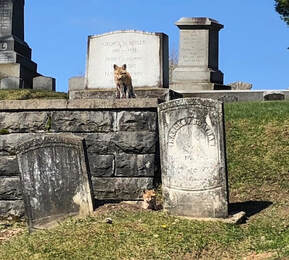 There is a family of red fox in a cemetery nearby and they have become a welcome diversion from all of the doom and gloom of the Covid-19 pandemic. I've been finding myself wandering the cemetery in the early morning and evenings, hoping to observe the pups playing. When the mother comes around, I take off so as not to distract them from their feeding routine. Watching them from a distance allows me to keep my mind off of other pressing concerns (the health and safety of my family) and made me realize that as we humans struggle with the impacts of this terrible pandemic, mother nature just keeps forging on. Because the red fox appears in two of my novels, I researched their ecology. Fox mate in late winter and produce 2-10 young by March-April. The mother builds two dens (one is a back-up). They may dig their own or take over previous holes dug by gophers. It is not uncommon for the mother to divide the litter between two dens. Unlike some other mammals that leave the care of the young to the mother, fox mates stay together to bring up the pups. The male will bring food for the pups to play with and eat until they can hunt on their own (12 weeks). They are omnivores, meaning they eat both meat and plants. I've seen bird feathers and carcasses near the den and one day I spotted one of the parents coming over the hill with what looked like a squirrel in its mouth. They are mostly active in the early evening or night but while taking care of the young, the parents may be seen hunting near the den. Sometimes at night I can hear the screeching and yipping of fox that live in the fields near our house. It's slightly eerie and almost sounds like they are in pain. This form of communication is mostly between mates. After 12 weeks, the pups disperse - males going first, to stake out new territory. The coyote and man are the fox's natural predators. It is still legal to hunt fox in the U.S. but not as common as it used to be. While I was researching one of my novels I found a reference to residents of the Smoky Mountains during the Great Depression, hunting fox and other fur bearing mammals to send the pelts to Sears and Roebuck for five dollars a pelt. And of course many of us know about fox hunting with hounds which has been banned in most places. In the U.S. it is now considered a 'chase' and they don't kill the fox. Nowadays, the lethal risk to fox is the coyote, which is increasing in number in the Northeaster U.S. , and disease. Since the stay-at-home and social distancing began I've been walking three to four miles a day to keep my mind off things. Checking in on the fox family has become a ritual and has saved me from wallowing in despair. It has also served as a reminder that the Mother nature keeps moving on no matter what we humans do. We will survive all of this. If anything, slowing down, walking outdoors because the gyms are closed, has been a godsend for a lot of us because we're reconnecting with the natural world. 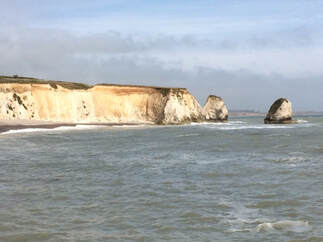 Chalk Cliffs at Freshwater Chalk Cliffs at Freshwater A few years ago I went to the village of Freshwater on the Isle of Wight, to scout out a location in my second novel of the Durant Family Saga trilogy: Castles in the Air. Freshwater is a step back in time. It appears nothing has changed in this small coastal village since one of the characters in my novel, Ella Durant visited it over one hundred years ago to meet the poet Alfred Lord Tennyson. Given its history I would be surprised if it wasn't a haven for artists and writers. The beauty of the cliffs and rolling hills is astounding. After finding Tennyson's home, Farringford, which is not open to the public, I went to the Dimbola Museum, once home of the famous photographer, Julia Margaret Cameron. I found a reference in a letter from Thomas C. Durant to his daughter Ella Durant dated April 1874 in which he stated he would allow Ella to stay with Mrs. Cameron in Freshwater. I speculate that the photo below may have actually been done by Cameron, although I don't know for sure. But in it Ella poses with her brother William and other friends at Isle of Wight, and it is dated 1874. Anne Thackeray Ritchie, an author and a family friend of Julia Cameron, stands tall in the back, facing right. 4/8/2020 Enough Already! Main entrance NY Public Library. Main entrance NY Public Library. In a interview on the History Author Show podcast about the Durant Family Saga, the interviewer asked me a question that had me stumped: If you could fill any gap about this fascinating family after three novels, what would you choose? Of course, there’s more I could have uncovered about the Durants to turn my trilogy into a series. I've received emails from people who were reading my books and my research journey blog. They offered me tidbits of information, leads to follow, contact information of descendants with interesting histories of their own. But for me, enough was enough. I’d spent five years of my life researching this Gilded Age family. I had traveled to several libraries and museums on the east coast of the U.S., and visited the Isle of Wight in England. At some point authors of historical fiction rely on conjecture. It is the lens we use to offer our interpretation of events given the information we have on hand. Indeed, at the end of the trilogy, in the novel, The Night is Done, the narrator, a historian, remarks: I’m sure that in the future, someone will come along and find gaps in my research. It’s the historian’s curse. Our job is to sift through the tall tales and determine what’s worth including and what’s best left as fodder for others to chew on. The truth is found in the abyss of the unknown. If my readers believe it’s me, the author saying these words, they aren’t far off. I put myself in the head of the narrator, a historian, tracking down and interviewing an elderly member of the Durant family, and by the time I was done writing the last book in the trilogy, it was how I felt. We read historical fiction to discover history in an interesting and entertaining fashion. Authors of this genre are all too aware that some research could take up a lifetime and if we wait for all the facts to be known, the stories would never get written. This is especially true as libraries, newspapers and museums digitize their collections making them more accessible to the public, uncovering new details and facts about historical events along the way. There are always new stories to tell, and I have moved on to tell them. My latest work in progress is about the men of the US Civilian Conservation Corps, who planted over a billion tree seedlings in the US during the Great Depression. The story revolves around the families who once lived in Cades Cove, a cultural heritage site at the Great Smoky Mountains National Park. After doing research about these families, I felt compelled to tell their stories. And I hope to have this novel published soon.You can read the first couple of chapters here. 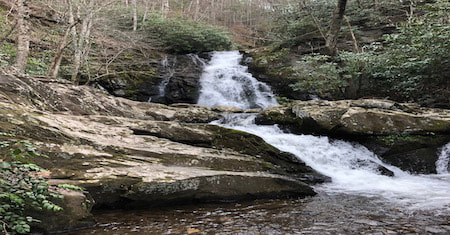 The sound of a stream plunging over a precipice is one sign of spring and on my recent visit to the Smoky Mountains National Park there were plenty of gushing waterfalls; I hiked up to Spruce Flats to get this view. 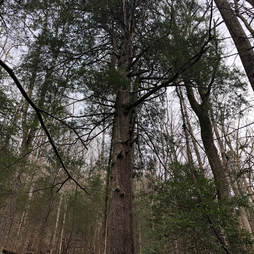 I went to the Smoky Mountains National Park to conduct research for a novel and to write about place, exploring the mountains in spring. I was especially interested in the area around the Tremont Institute in the park. It was once a thriving lumber community and one of the more famous inhabitants was William Walker. He owned most of Walker Valley before the Smoky Mountains National Park was formed, and this is where my fictional family lives. What drew me to their story is the old growth, or what is left of it at the Tremont Institute in the park. William Walker settled here in the 1850s and as lumber operations closed in on his valley, he tried to keep his old growth woods from the clutches of the Little River Lumber Company. William lived a colorful life. According to his descendants, he had three wives and some estimate he sired over 20 children. He hung on to his land until 1918, selling it off to the owner of the Little River Co. on his death bed with the understanding that the old trees would be spared. What he never knew was that eventually his trees were cut, post-mortem, by the company and that he was under paid for the land. A few miles down the road from Tremont and Walker Valley is the only cultural heritage site in the park - Cades Cove. This eleven mile circuit holds what remains of an entire community that once lived there: homes, corn cribs, barns, smoke and spring houses. The people that lived in Cades Cove had full, industrious lives. 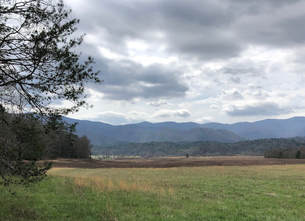 A cove is another name for valley. Large area of flat land between mountains. A cove is another name for valley. Large area of flat land between mountains. Their economy was based on a bartering system with the nearby cities and towns. And they had plenty to barter before the woods were ravaged by blight, forest fire, and habitat destruction. Ginseng, chestnuts, corn, and cattle were just some of the products the people of Cades Cove bartered and sold at markets in Maryville and Knoxville, TN. Luckily local residents (many descendants) from nearby Townsend, Tennessee advocated for preserving the architecture of Cades Cove. It is the only area in the park where you can find everything intact. Which was fortunate because when the government started acquiring land for the park in the mid-1920s they tore down or let buildings rot after their occupants moved out. Just like the natural areas in the park, Cades Cove is a great place to rocket the imagination. I also found a plethora of reading material at the Smoky Mountains Heritage Museum in Townsend, first hand accounts from people who grew up in the region before their families were forced to move because of the National Park in the mid 1930s. These books are gold mines of information, tall tales, and stories about the families who lived there, their hardships, feuds, and industry. Before a fungus blighted the Chestnut trees, children would go deep into the woods to collect the nuts and sell them at the local stores. They had a miller who came in from the fields at the sound of a bell to mill corn for customers who stopped in with a sack of kernels. His was an important job as corn was a family staple and wheat was hard to grow so flour was usually shipped in and store bought. The families raised pigs, notched their ears to identify them and let them roam the hills. At harvest time they were lured in with salt and nuts. The meat was kept in a smokehouse and slabs taken off throughout the winter. Game was scarce by the early 20th century due to over hunting. Hunters were lucky to get a 'Gobbler' roosting in a tree, or squirrel meat. I found no references for deer hunting but Elk now pasture in the coves and there are signs everywhere to be aware of them while driving. I've visited the park twice and have yet to see one. But I'll be back for the next season: summer and maybe I'll get lucky. Connect here for my next post on the history of lumber industry in the Smoky Mountain region.
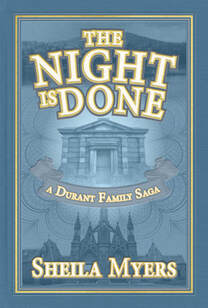 From Kirkus Review A historical novel, set largely in upstate New York’s Adirondack Park, about the troubled lives of real-life real estate investor William West Durant and his embittered sister, Ella. Myers (Castles in the Air, 2016, etc.) continues the story of the Durants in this third book in her Durant Family Saga trilogy. Thomas C. Durant was a railroad magnate who lost a fortune and died under a cloud—and intestate—in 1885. His son, William, assumed control of the family’s remaining assets and began new real estate and construction ventures in the Adirondacks. His sibling, Ella, who was somewhat of a bohemian, always felt financially shortchanged and ill-treated by her older brother—which caused litigation between the two. In the novel, told in the form of reminiscences of various characters, readers follow the arc of William’s career from his early days as a high roller (starting in 1892) to his impoverished life as an old man (circa 1931). In the end, not only has William lost all of his own wealth, but also money and land that Ella won in her final lawsuit—so they both end up losing. However, as William wrote to a friend in 1932, “I am poor, but I am happy, what more can most of us expect?” Myers writes with skill and has chosen well in deeply researching the Durant saga, which remarkably parallels Greek tragedy. It’s a truly engrossing story, and Myers does it justice. William is effectively portrayed as being more clueless than anything else, as he honestly doesn’t understand that he is treating his sister—and his wife, for that matter—very badly. He’s also obsessed with his camps in the Adirondacks, giving readers the impression that he sees the whole park as his personal fiefdom. That’s likely the reason why Myers uses the very clever gambit of telling the story from the perspective of William in his old age, when he’s “calm of mind, all passion spent,” and being interviewed by wealthy Harold Hochschild, who now owns William’s old camp, Eagle’s Nest. To compare William to the aged Oedipus is not so great a stretch. A well-wrought, classically inspired riches-to-rags tale. 1/30/2020 The Anatomy of a Historical Novel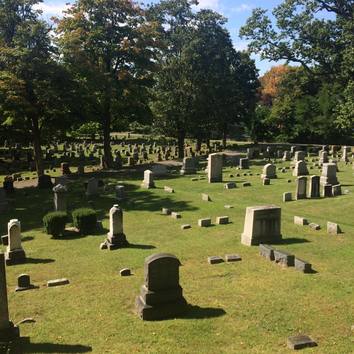 Fort Hill Cemetery, Auburn NY Fort Hill Cemetery, Auburn NY Often, when I'm giving a talk about my novels I'm asked, where did you come up with the idea to write the story? I get my inspiration from past. I started to research the Durant family saga - after staying in a cabin hidden in the wilderness that was supposedly built by William West Durant for trysts with his mistress. What I thought would be a one book love story/romance, turned into a four year research journey. This folklore about William and his mistress started me down a path of clues that shed light on the lives of the Durant family and had me visiting the New York Public Library, the Library of Congress, Winterthur Museum, the Adirondack Museum, and England. My one book idea turned into a trilogy. Soon after I was finished with my draft of novel three in the trilogy, I was visiting my family in South Carolina and ended up hiking in the Great Smoky Mountains, one the US most popular National Park. I was intrigued with the history of the people who once lived in the park and were eventually forced out--like the residents of Cades Cove--now a Cultural Heritage site in the park. And then there is the story of the Walker Sisters, who, due to their age, were allowed to stay in their cabins until they died. I found fascinating oral histories about the former residents in the bookstore of the Smoky Mountains Cultural Heritage Museum in Townsend, TN. While the research is a slow and steady task, never really ending, a lot of it can be done via use of digital archival material. However, the writing takes dedication. I'm lucky enough to be in an academic profession that allows me chunks of time to write. In the summer months I spend the mornings in a library or coffee house writing until I reach 3k words (usually about two-three hours). I do this until I have a rough draft of a novel - about 80k words. Editing takes another year if not more. Indeed, I am still editing the novel I wrote set in the Great Smoky Mountains, The Truth of Who You Are, as it is now out on submission with publishers. Once in a while I panic, thinking, will I ever run out of ideas on what to write about? What if this novel is my last? Can I keep up with the research and the creative process involved in putting out a novel set in the past about real people and events? Recently, while walking in the famous Fort Hill Cemetery in Auburn, NY where Harriet Tubman, and William Seward are buried, I thought about how many stories there are to tell and thought, "I'll ever run out of material."  Myers (Imaginary Brightness) satisfyingly concludes her historical trilogy set in the Gilded Age by presenting the detailed downfall of ruthless real estate mogul William West Durant; his exasperated wife, Janet; and his estranged sister, Ella. In 1931, the penniless Durant recounts his tragic life. After inheriting his father’s vast wealth and interest in the Adirondack Railroad, William immediately begins to make bad investments. He squanders money on yachts, panders to princes, and builds mansions he can’t afford to run, all while hiding assets from Ella. She sues him for her rightful inheritance and tries to overcome discrimination to become a novelist. Meanwhile, Janet, verbally abused and infantilized by William, begins an affair with her doctor. After getting proof of William’s own infidelities with an actress, Janet sues for divorce.....Myers expertly depicts a precarious era soaked in vicious gossip, stained reputations, and ostentatiousness. Readers will enjoy the historical details that bring this Gilded Age soap opera to life. (BookLife) 7/20/2019 Forever Wild in the Adirondacks One of the pleasures of being an author is meeting with people at unique places to talk about books. This summer I met with teachers who were participating in the State University of New York Cortland Forever Wild in the Adirondacks. Teachers from various disciplines came from all over the country to stay in and learn about the Adirondack Great Camps built during the Gilded Age. History Professors Randi Storch and Kevin Sheets organized the event with a grant from the National Endowment for the Humanities. The week's itinerary included lectures on the history of land use in the region, and how it impacted the people who lived there. There were discussions on urbanization and industrialization, the respite wilderness offered for those living and working in the cities, and the romantic view people had about 'roughing it'. I spoke about the Durant family, who once owned over 1/5 million acres of land in the Adirondack Wilderness, and their plans to exploit it by developing a transportation system into the interior. 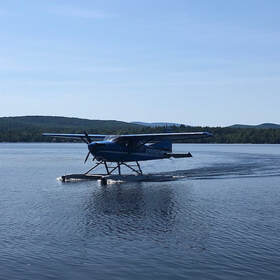 The teachers stayed at a Great Camp built by William West Durant and now owned by SUNY Cortland. Camp Huntinginton. They were even treated to an aerial view of the property with sea plane rides. 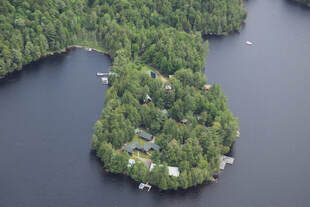 Activities included visits to other Great Camps built by Durant, (pictured below are the teachers from week 2 in front of Great Camp Sagamore), camp fire discussions about the readings, kayaking and paddle boarding on Raquette Lake. I was able to participate for one of the days and enjoyed a glorious sunset at the end. I was so grateful to be a part of the program and to meet so many dedicated teachers. 6/28/2019 The Mayflies are Hatching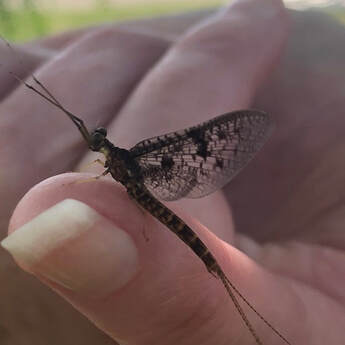 It's almost the fourth of July and the mayflies have hatched in the Finger Lakes region - always a good sign. Mayflies have adapted to every aquatic situation except foul water - that is according to Anne Haven Morgan - aka Mayfly Morgan, known for her study of aquatic life in the early 1900s. I have a first edition copy of her book, titled Field Book of Ponds and Streams, published by Putnam in 1930. It contains over 250 illustrations and plates done by Morgan who was a Professor of Zoology at Mount Holyoke College. So popular was her little field guide it was used by students of Biology at Cornell University back in the day (personal communication from John Weeks, a naturalist from the area who attended Cornell in the 1930s). 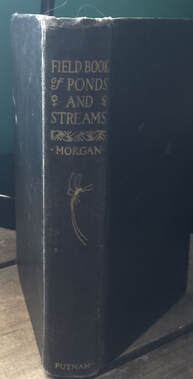 Mayflies hatch in the early summer after spending most of their life as nymphs under water, breathing through gills found on their abdomen. When they reach adulthood, they climb up a stem or reed and molt (depending on the species it could take hours or days). They have no mouth parts but they have wings for flight. They don't eat at this stage; their only job is to procreate. The fishermen call them duns or spinners because of their mating flight that begins at twilight. They swing up and down in the air like the seeds of a cottonwood tree, flinging upwards of thirty feet. Hundreds of them will perform this dance over the water. Once done, the females dip their tails ever so delicately on the lake to lay their eggs. It looks like soft raindrops pattering on the surface. After the act is completed, the females die, forming mats on the surface, becoming food for ducks and fish. The males also have a short lifespan as adults. They mate and alight on the nearest tree where they spend for their final hours. Hence the Latin name given to the insects - Ephemeroptera - meaning ephemeral- short lived. Like our summers in the Finger Lakes. According to Morgan's field guide, Dr. F.H. Krecker observed so many dead mayflies after a hatch on the shores of Cedar Point, Lake Erie, that there were piles of them, six-eight inches deep under the street lights. The local amusement park had to haul their lacey bodies in carts each morning. Those must have been the days before industrial pollution and harmful algae blooms started choking the waters of the lake. 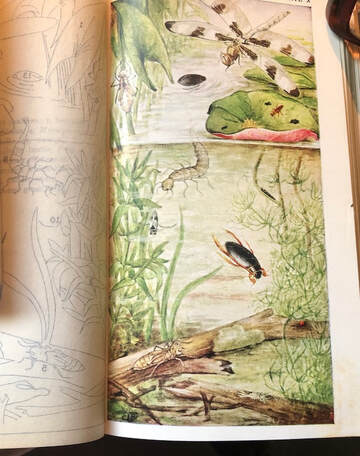 Anne Haven Morgan's Field Guide to Ponds and Streams Plate X Anne Haven Morgan's Field Guide to Ponds and Streams Plate X You can see how delicate these creatures are in the plate illustration from Morgan's field guide. At the very bottom, on a log to the right, is the nymph looking like a skeleton. The larger insect to the left is a dragonfly nymph (yes dragonflies spend their nymph stage under water as well and breath through gills inside their abdomen). I fell in love with mayflies when I first started studying aquatic science and collected them as part of stream studies. I even went so far as to include their life history in my novel set in the Finger Lakes after their Latin name - Ephemeral Summer. Their short life span is beautifully tragic, yet purposeful. Which in the scheme of things could be said about most living creatures. |
AuthorSheila Myers is an award winning author and Professor at a small college in Upstate NY. She enjoys writing, swimming in lakes, and walking in nature. Not always in that order. Archives
March 2023
CategoriesAll Adirondacks Algonquin Appalachia Award Canada Chestnut Trees Christmas Civilian Conservation Corps Collis P. Huntington Creativity Doc Durant Durant Family Saga Emma Bell Miles Finger Lakes Great Depression Hell On Wheels Historical Fiction History Horace Kephart Imagination National Parks Nature Publishing Review Screenplay Short Story Smoky Mountains Snow Storm Stone Canoe Literary Magazine Thomas Durant Timber Wilderness World War II Writing |
|
|
All materials Copyright 2022
Any reproduction, reprint or publication without written consent of author prohibited. |
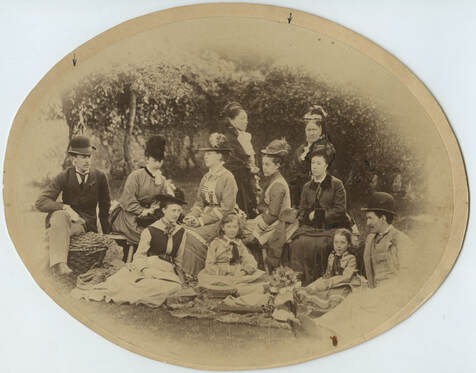
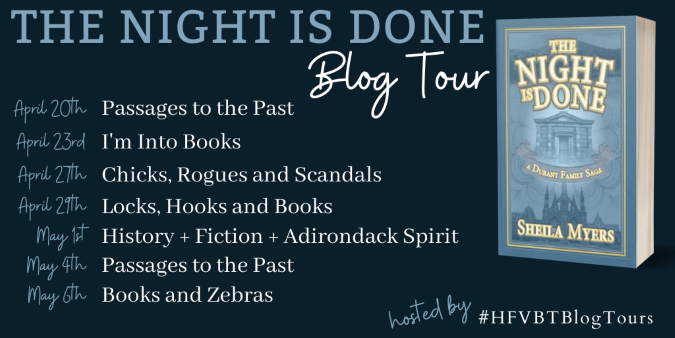
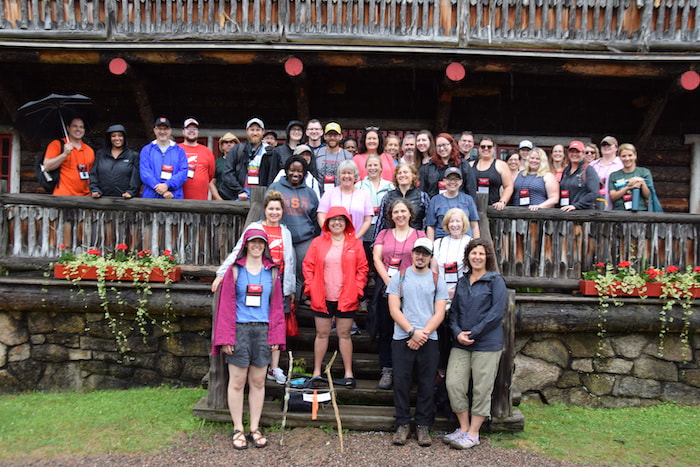
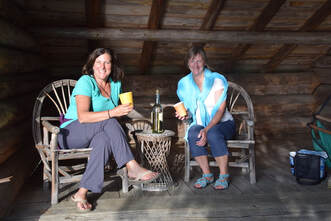
 RSS Feed
RSS Feed